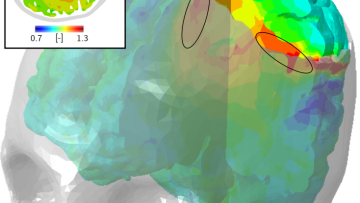For over a hundred years, when confronted by swelling in the brain, surgeons more often than not have resorted to decompressive craniectomy, the traditional route to reducing swelling by removing a large part of the skull. However, while this might be the standard procedure, its failure rate has been worryingly high, primarily because the consequences on the rest of the brain have been poorly understood.
16:00
Random waves on the three-dimensional torus and correlations of spherical lattice points
Abstract
I will discuss some recent work, joint with R. Maffucci, concerning random Laplace eigenfunctions on the torus T^3=R^3/Z^3. Studying various statistics of these 'random waves' we will be confronted with an arithmetic question about linear relations among integer points on spheres.
16:00
On the standard L-function attached to Siegel-Jacobi modular forms of higher index
Abstract
In this talk we will start by introducing the notion of Siegel-Jacobi modular form and explain its close relation to Siegel modular forms through the Fourier-Jacobi expansion. Then we will discuss how one can attach an L-function to an appropriate (i.e. eigenform) Siegel-Jacobi modular form due to Shintani, and report on joint work with Jolanta Marzec on analytic properties of this L-function, extending results of Arakawa and Murase.
16:00
Correlations of multiplicative functions
Abstract
We develop the asymptotic formulas for correlations
\[ \sum_{n\le x}f_1(P_1(n))f_2(P_2(n))\cdot \dots \cdot f_m(P_m(n))\]
where $f_1,\dots,f_m$ are bounded ``pretentious" multiplicative functions, under certain natural hypotheses. We then deduce several desirable consequences: first, we characterize all multiplicative functions $f:\mathbb{N}\to\{-1,+1\}$ with bounded partial sums. This answers a question of Erd{\"o}s from $1957$ in the form conjectured by Tao. Second, we show that if the average of the first divided difference of multiplicative function is zero, then either $f(n)=n^s$ for $\operatorname{Re}(s)<1$ or $|f(n)|$ is small on average. This settles an old conjecture of K\'atai. Third, we discuss applications to the study of sign patterns of $(f(n),f(n+1),f(n+2))$ and $(f(n),f(n+1),f(n+2),f(n+3))$ where $f:\mathbb{N}\to \{-1,1\}$ is a given multiplicative function. If time permits, we discuss multidimensional version of some of the results mentioned above.
16:00
Effective equidistribution of rational points on expanding horospheres
Abstract
The equidistribution theorem for rational points on expanding horospheres with fixed denominator in the space of d-dimensional Euclidean lattices has been derived in the work by M. Einsiedler, S. Mozes, N. Shah and U. Shapira. The proof of their theorem requires ergodic theoretic tools, including Ratner's measure classification theorem. In this talk I will present an alternative approach, based on harmonic analysis and Weil's bound for Kloosterman sums. In the case of d=3, unlike the ergodic-theoretic approach, this provides an explicit estimate on the rate of convergence. This is a joint work with Jens Marklof.
16:00
Arithmetic applications of $\omega$-integral curves in varieties (Joint with Logic)
Abstract
In 2000, Vojta solved the n-squares problem under the Bombieri-Lang conjecture, by explicitly finding all the curves of genus 0 or 1 on the surfaces related to this problem. The fundamental notion used by him is $\omega$-integrality of curves.
In this talk, I will show a generalization of Vojta's method to find all curves of low genus in some surfaces, with arithmetic applications.
I will also explain how to use $\omega$-integrality to obtain a bound of the height of a non-constant morphism from a curve to $\mathbb{P}^2$ in terms of the number of intersections (without multiplicities) of its image with a divisor of a particular kind.
This proves some new special cases of Vojta's conjecture for function fields.
16:00
On Hodge-Tate local systems
Abstract
I will revisit the theory of Hodge-Tate local systems in the light of the p-adic Simpson correspondence. This is a joint work with Michel Gros.
16:00
An Arithmetic Chern-Simons Invariant
Abstract
Abstract: We will recall some analogies between structures arising from three-manifold topology and rings of integers in number fields. This can be used to define a Chern-Simons functional on spaces of Galois representations. Some sample computations and elementary applications will be shown.
16:00
Representation of integers by binary forms
Abstract
Let $F$ be a binary form of degree $d \geq 3$ with integer coefficients and non-zero discriminant. In this talk we give an asymptotic formula for the quantity $R_F(Z)$, the number of integers in the interval $[-Z,Z]$ representable by the binary form $F$.
This is joint work with C.L. Stewart.
15:00
Long-term security
Abstract
The amount of digital data that requires long-term protection
of integrity, authenticity, and confidentiality protection is steadily
increasing. Examples are health records and genomic data which may have
to be kept and protected for 100 years and more. However, current
security technology does not provide such protection which I consider a
major challenge. In this talk I report about a storage system that
achieves the above protection goals in the long-term. It is based on
information theoretic secure cryptography (both classical and quantum)
as well as on chains of committments. I discuss its security and present
a proof-of-concept implementation including an experimental analysis.


